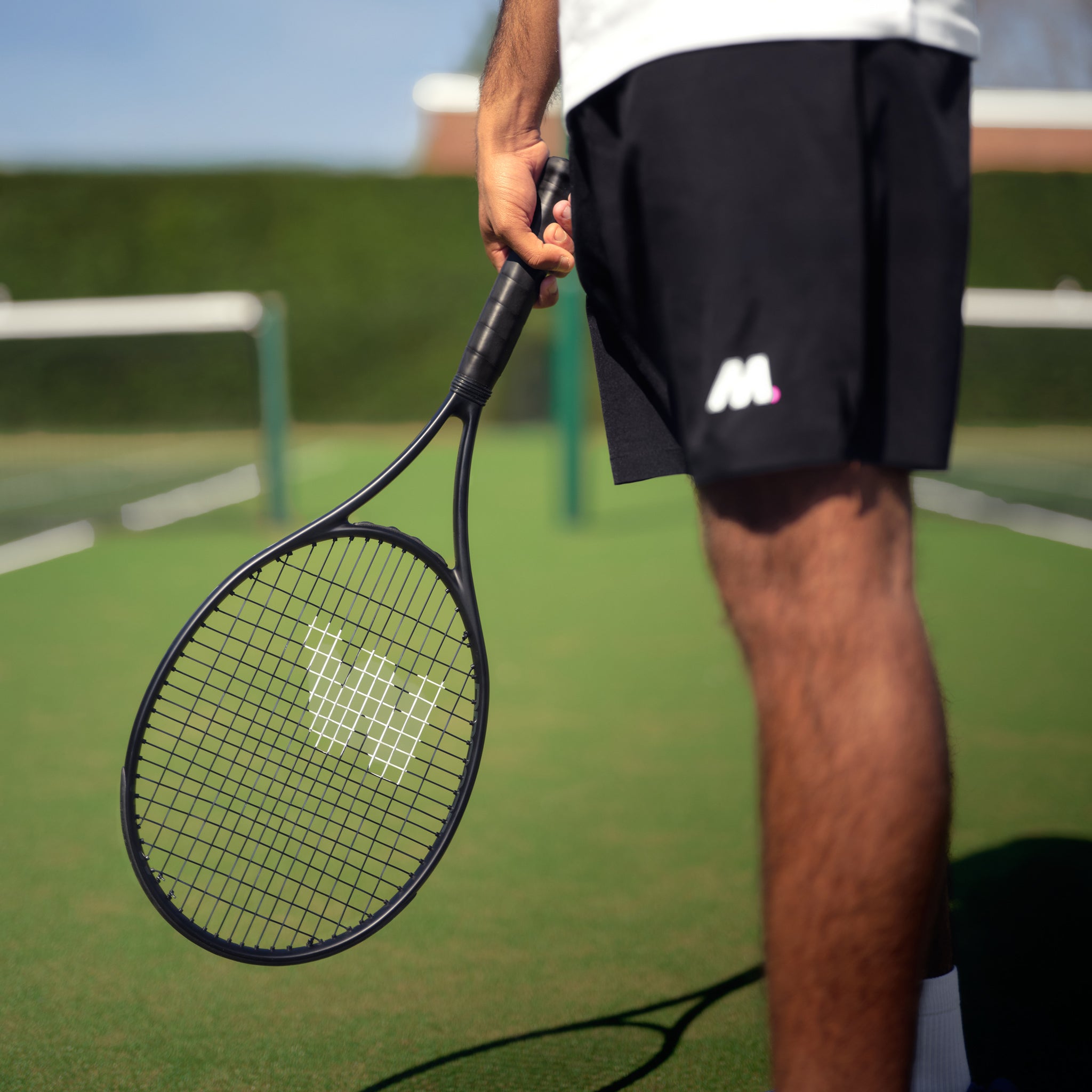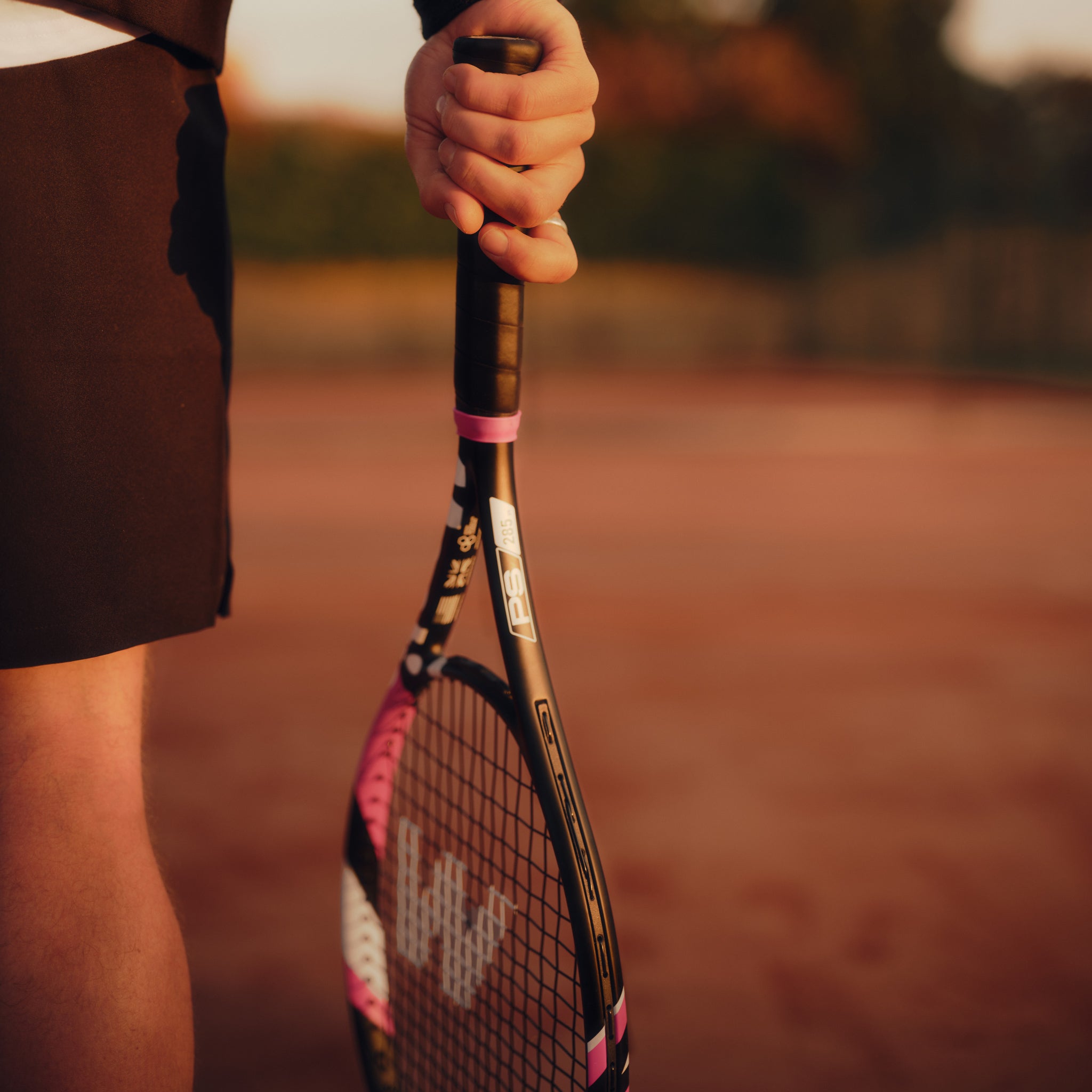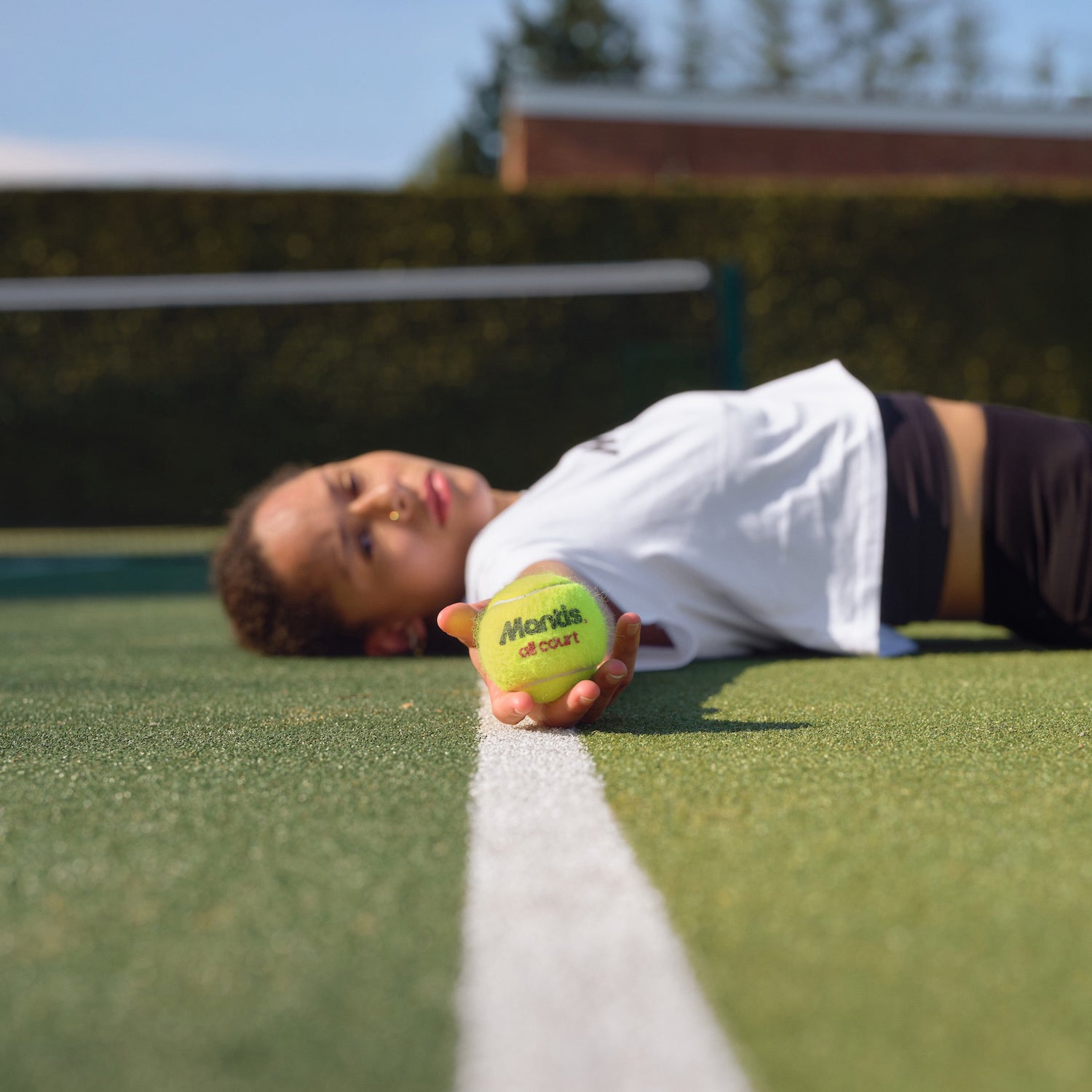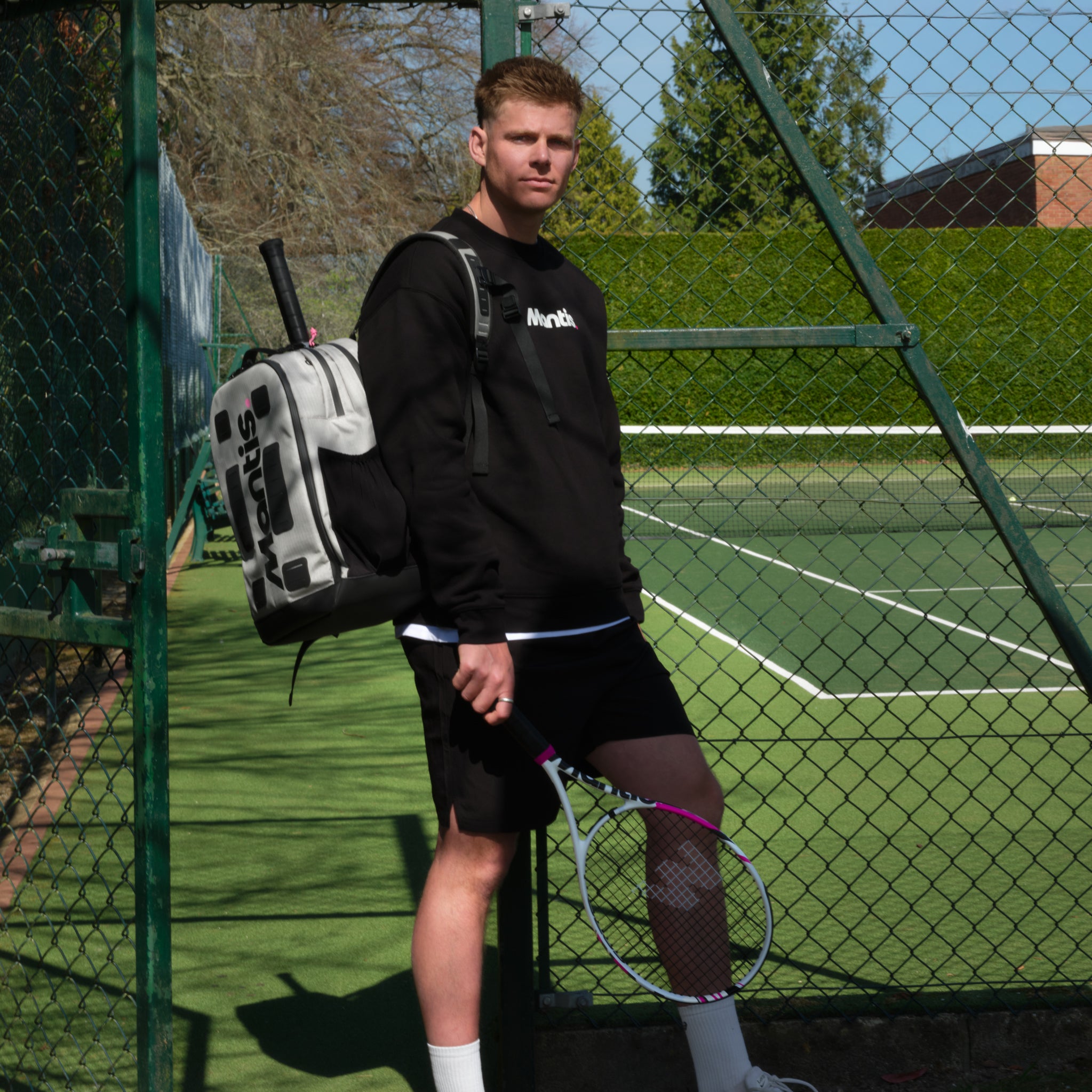
Choosing the right equipment is one of the first, and most important, steps in nurturing a child's love for tennis. The right junior size tennis racket is absolutely essential for building solid technique, preventing injuries, and most importantly, making sure they have fun on the court. To get started, our detailed junior tennis racket size chart is a fantastic resource for matching your child’s height with the perfect racket size.
Why Your Junior Size Tennis Racket Matters
Picking out a racket for a young player isn’t just about the colour or brand—it’s a decision that will directly shape how they develop and whether they stick with the game.
If a racket is too heavy, too long, or poorly balanced, a child will be forced to develop awkward, compensatory swing mechanics just to get the ball over the net. Those bad habits can be incredibly difficult to unlearn later on.
Worse still, an improperly sized racket is a leading cause of avoidable injuries. The repetitive strain of swinging a frame that’s too much for their small muscles and joints can lead to problems in the wrist, elbow, and shoulder.
The Foundation For Proper Technique
A racket that fits well feels like a natural extension of a player's arm. It allows them to learn the correct swing path without thinking about it, freeing them up to focus on footwork, timing, and making clean contact with the ball. This is how a solid technical foundation is built.
- Improved Control: A suitable racket helps a child guide the ball with far greater accuracy.
- Enhanced Feel: They can actually sense the connection between the string bed and the ball.
- Natural Power Generation: It teaches them to use their whole body to generate power, not just their arm.
At Mantis, we see proper equipment as non-negotiable for a young athlete's growth. It’s the first step in building a lifelong love for tennis by making those early experiences on court positive and successful.
Market Growth And Player Safety
This focus on the right gear isn't just a coaching tip; it's a trend shaping the entire industry. The junior racket market is a significant and growing segment, with kids' models accounting for roughly 15% of all tennis racket sales worldwide.
This growth is being fuelled by innovations in lightweight materials and ergonomic designs that make rackets safer and more playable for young athletes.
Of course, equipment is only one piece of the puzzle. Taking a holistic approach to a child’s athletic journey is crucial. Understanding how to manage their physical load and recovery is vital for long-term health and enjoyment.
This guide will walk you through everything you need to know, making sure you can choose with confidence.
How to Properly Measure for Racket Length
Before you even start looking at cool designs or your favourite player’s brand, we need to get one thing right: the length. This is, without a doubt, the most important first step. While those age and height charts you see online are a decent starting point, nothing beats a quick, hands-on measurement to guarantee a perfect fit. If you’re after more general advice, you can find a lot more in our complete guide on how to choose a tennis racket.
Here at Mantis, we always steer parents and coaches towards a simple, fail-safe technique we call the 'floor-to-fingertip' method. It’s the best way to make sure the racket is properly scaled to the young player’s body.
The process is super straightforward and you can do it right in the shop or at home. Just have your child stand up straight and relaxed, with their arms hanging naturally at their sides. No tension, no reaching.
Next, take a junior racket and stand it on its head, with the very top of the frame touching the floor right beside the foot of their dominant hand. The handle should be pointing straight up to the ceiling.
The Fingertip Test
Now for the moment of truth. With their arm hanging loosely next to the upright racket, check where their fingertips land. The bottom of the racket's handle, known as the butt cap, should just about graze the tips of their fingers.
They shouldn't have to bend their arm, stretch their fingers, or lean over to make it touch. If the butt cap sits squarely in their palm or extends past their fingertips, that racket is too long. And if they have to reach down for it, it’s too short.
This simple test is the gold standard for sizing a junior racket. It’s the ultimate confirmation that the frame's length will allow for a natural, flowing swing—which is absolutely vital for developing good form and protecting their growing joints from strain.
This picture shows exactly what you’re looking for.

Notice how the racket’s butt cap lines up perfectly with the player’s fingertips. There's no awkward bending or stretching, which tells you it’s an ideal fit.
Why This Method Is Superior
Sure, age and height charts are handy for getting you in the right ballpark, but they’re a blunt instrument. They just can't account for individual differences in body proportions—especially arm length. You could have two kids of the exact same height who need slightly different racket lengths.
The floor-to-fingertip test cuts through all the guesswork. It’s a real-world check that confirms the racket will work with your child’s unique build, not against it. A racket that’s even slightly too long is a recipe for trouble, leading to a whole host of problems:
- Awkward Swing Mechanics: It forces a player to make unnatural adjustments, often causing them to hit the ball late and develop bad habits.
- Increased Risk of Injury: That extra length and leverage puts a surprising amount of stress on the wrist and elbow.
- Poor Shot Control: The racket becomes clumsy and much harder to manoeuvre, making clean, consistent contact a real challenge.
Getting the length right is the foundation for everything that follows. It truly sets a young player up for success, letting them focus on learning and loving the game with equipment that feels like a natural part of them.
Once you’ve figured out the right length, the next thing to tackle is the racket's head size and its weight. These aren't just minor details on a spec sheet; they have a massive impact on a young player's ability to make clean contact with the ball and, just as importantly, build confidence.
At Mantis, we spend a lot of time guiding players through these choices. It’s all about finding that sweet spot where the gear supports their development, not hinders it. You can see how these principles apply across our full range of tennis equipment.
These two factors really determine how forgiving a racket is and how it feels in the hand during a swing. Get them right, and you'll see practice translate directly into better performance on the court.
Decoding the Head Size
A racket's head size, measured in square inches, is simply the size of its hitting area. For a kid who's just starting out, a larger head size is a huge advantage because it creates a much bigger "sweet spot".
This generous hitting area makes the racket more forgiving on those inevitable off-centre shots. That’s a game-changer when a player is still getting the hang of their hand-eye coordination. It helps them connect with the ball more often, which keeps the game fun and cuts down on the frustration.
As a player gets more experienced and their technique solidifies, they can start thinking about a junior tennis racket with a slightly smaller head. This gives them a bit more control and precision, perfect for players who can reliably find the middle of the strings.
- Oversize Heads (100+ sq. in.): These are perfect for beginners. They offer maximum forgiveness and a huge sweet spot, which is brilliant for building early confidence.
- Mid-plus Heads (95-100 sq. in.): This is a great middle ground. It suits intermediate juniors who are starting to develop more control but still need that forgiving frame to back them up.
- Midsize Heads (Below 95 sq. in.): Reserved for advanced juniors. These players have solid, repeatable technique and need the extra control and feel for competitive matches.
Finding the Right Racket Weight
Working hand-in-hand with head size is the weight of the frame. The racket's "strung weight" influences everything from how fast a kid can swing it to how stable it feels when they make contact.
It makes sense that lighter rackets are easier for a child to swing. They can generate good racket head speed without putting too much strain on their developing muscles. This is ideal for younger kids or anyone in the early days of learning proper form.
But as a player gets stronger and starts facing opponents who hit with more pace, a slightly heavier racket becomes a real asset. It's less likely to twist in their hand on impact and provides more "plough-through" and power. Think about it this way: a 9-year-old just starting lessons will have a much better time with a light, oversized frame. A competitive 13-year-old, however, will need the stability of a heavier racket to handle and return fast shots with authority.
The goal is to find the heaviest racket a child can comfortably swing without it messing up their technique. Too light, and it will get pushed around by the ball. Too heavy, and it will cause fatigue and encourage bad habits.
It's an interesting balancing act, and it's probably why so many parents prefer to buy rackets in-store. In 2022, offline retail channels made up 56.3% of all tennis racket sales revenue in the UK. This really highlights that people want to physically feel the grip, length, and weight of a junior racket before committing. That hands-on experience helps ensure the racket just feels right, something a spec sheet online can't always guarantee.
Comparing Racket Materials and Construction
The material a junior racket is made from has a massive say in how it plays, how long it lasts, and just as importantly, how it feels in a young player's hand. At Mantis, we want to help you make sense of the options out there, from the most basic entry-level frames all the way up to the performance models. When you're looking at a junior size tennis racket, it's worth exploring our full Mantis tennis racket range to see these material differences in action.
Ultimately, choosing the right one is a balance between your child's current skill, their commitment to the sport, and your budget. Getting it right can make a huge difference to their on-court experience and development.
Aluminium: The Starting Point
For the youngest players just getting their first taste of tennis, aluminium is the go-to material. It’s affordable, lightweight, and very durable—a perfect combination for a racket that’s probably going to see a few bumps and scrapes.
These rackets are all about fun and discovery. They provide just enough feedback for a child to learn the basics without the higher price tag of more advanced frames. If your kid is just trying out the sport at a summer camp or having a casual hit in the park, an aluminium racket is an excellent, practical choice.
Graphite Composite: The Next Step Up
Once a player’s skills start to take off, they’ll often outgrow the capabilities of a basic aluminium frame. This is where graphite composite rackets come into the picture. These frames cleverly blend graphite with other materials like fibreglass or aluminium.
This mix offers a really noticeable improvement in playability.
- More Power: Graphite adds stiffness, which helps your child generate more power on their shots.
- Better Feel: The composite construction absorbs more vibration than pure aluminium, giving them a much cleaner feel at contact.
- Improved Control: These rackets are more stable, which really helps with shot accuracy as a player starts to rally more consistently.
A graphite composite racket is ideal for the junior player who is taking regular lessons and is starting to take the game a bit more seriously.
Choosing to move from aluminium to a graphite composite is a key transition. It signals a shift from simply playing to actively developing skills, providing the player with a tool that can keep up with their growing abilities.
Full Graphite: The Performance Choice
For the dedicated junior who plays frequently, competes in tournaments, or is clearly on a development pathway, a full graphite racket is the standard. These are essentially scaled-down versions of adult performance rackets, offering the best in power, control, and feel.
Full graphite is significantly lighter and stronger than aluminium. This allows for a frame that is powerful yet easy to swing—a crucial combination for preventing arm fatigue. One of its biggest advantages is superior vibration dampening. This protects a developing player's arm from the shock of repeated impacts, which is incredibly important for injury prevention.
Making the move to a full graphite junior size tennis racket is a real investment in a player's tennis journey. It equips them with the same material technology used by the pros, giving them the best possible chance to refine their technique and unlock their full potential on the court.
Junior Racket Material Comparison
To help you visualise the differences, here’s a quick comparison of the common materials you'll find in junior tennis rackets. This table breaks down what each material is best for, its performance characteristics, and what you can generally expect to pay.
| Material Type | Best For | Performance Characteristics | Typical Price Range |
|---|---|---|---|
| Aluminium | Absolute beginners, casual play, first-time players (ages 2-8). | Lightweight, very durable, forgiving, but offers limited feel and power. | £ |
| Graphite Composite | Developing juniors, players taking regular lessons, moving beyond basics. | A blend of power and control. Better vibration dampening and feel than aluminium. | ££ |
| Full Graphite | Serious, competitive juniors, tournament players, advanced skill levels. | Maximum power, control, and feel. Excellent vibration dampening to protect the arm. | £££ |
Think of this as a roadmap for your child's equipment. As their game grows, the racket material they use should evolve with them, ensuring they always have the right tool for their stage of development.
Knowing When It's Time to Upgrade
A junior tennis racket is a brilliant tool, but it's built for a specific chapter in a player’s development. Just like they outgrow shoes, young players will eventually outgrow their racket. Recognising the signs for an upgrade is a crucial part of supporting their progress on court. When that moment comes, you can find the perfect next step in our full range of Mantis tennis equipment.
Moving up to the right frame at the right time is absolutely key to unlocking their potential.
The most straightforward signal is simple physical growth. That reliable floor-to-fingertip test we talked about earlier isn’t just a one-time thing; it’s an ongoing check. If you see your child having to bend their arm to stop the racket from dragging, or the handle now sits deep in their palm instead of at their fingertips, the frame is officially too short.
A racket that's too small cramps their swing and makes it inefficient. It forces players into awkward adjustments, which can compromise their technique and seriously limit their reach.
Looking Beyond Physical Growth
Height isn't the only factor. A player's skill progression is another massive signal that an upgrade is on the horizon. Is your child starting to generate some real pace but struggling to keep the ball in the court? This is a classic sign they've outgrown the capabilities of a basic junior size tennis racket.
Beginner frames are designed for forgiveness, not for handling power with precision. As a player gets stronger and their swing gets faster, they need a frame that can stand up to that increased force without twisting on impact.
A common scenario we see is a junior who can hit powerful groundstrokes in practice but loses all control during a match. Their current racket is likely too light or flexible, causing it to wobble on contact and spray the ball wide. Upgrading to a slightly heavier, more stable frame can provide the control they need to match their newfound power.
Specific Scenarios That Scream "Upgrade"
Deciding when to move up isn't always a clear-cut decision. Here are a few specific situations that strongly suggest a player's current racket might be holding them back:
- Complaints of a "dead" or "tinny" feel: As players develop a better feel for the ball, they'll notice the limitations of basic aluminium rackets. If they say the frame feels hollow or lacks feedback, they're ready for a higher-quality material like full graphite.
- Shots consistently landing short despite good technique: If their shots are dropping near the service line even with a full, confident swing, their racket is probably too light to provide the necessary "plough-through." A heavier frame will help them drive the ball deeper into the opponent's court.
- Visible frustration with control: Watch their body language. If they're looking at their racket in disbelief after missing a routine shot they normally make, the equipment could very well be the culprit.
This focus on matching equipment to a player's development is a huge driver in the tennis market. The UK, in particular, is a significant part of Europe's tennis scene, which is projected to hold about 26.86% of the global tennis racket market in 2025. The UK alone is expected to make up approximately 13.32% of that European share.
This strong demand is sustained by a grassroots focus on junior development from clubs and organisations across the country. It’s this dedication that ensures young players have access to the right gear as they advance through the sport.
Got Questions About Junior Rackets? We've Got Answers
Picking out the right racket for a young player can bring up a lot of questions. As a parent or coach, you want to get it right, and we're here to help you feel completely confident in your decision. If you're looking for a deeper dive, our full guide on how to choose a tennis racket is always available.
Here at Mantis, we've heard them all. Let's tackle some of the most common queries to clear up any lingering doubts.
Our aim is to give you all the information you need to find the perfect frame for your junior star.
Does My Child's Racket Need to Be Restrung?
This is a fantastic question, and the answer really comes down to the player's level and the kind of racket they're using. For youngsters just starting out with a basic aluminium frame, the factory strings are more than adequate. They’re built for durability and are perfectly fine for learning the fundamentals.
However, once a player starts to improve and moves on to a graphite composite or a full graphite frame, restringing becomes a game-changer. Fresh strings offer a noticeably better feel, a more consistent response off the stringbed, and far greater control.
As a rule of thumb, we suggest restringing a performance junior racket at least twice a year. If your child is playing several times a week or competing in tournaments, you'll want to do it more often. A great tip is to use a softer string, like a multifilament, to help protect their developing arm from harsh shock and vibration.
How Do I Know What the Right Grip Size Is?
Most junior rackets are designed with a standard, one-size-fits-all grip (usually marked as L0 or 4 inches) that suits the average child for that racket length. For the most part, this works out just fine.
But it’s always smart to double-check. Have your child hold the racket with a forehand grip. You should be able to slide your index finger into the gap between their fingertips and the base of their palm.
- A grip that’s too big is awkward to hold. It restricts wrist movement, which is crucial for serves and smashes, and can lead to strain.
- A grip that’s too small forces them to squeeze too hard. This can cause unnecessary fatigue in their hand and forearm muscles.
Should I Buy a Racket for My Child to "Grow Into"?
We get the temptation—it seems like a practical way to save money. However, we strongly advise against it. Buying a racket that is too big or too heavy right now can do more harm than good.
A frame that's too long or heavy forces a child to develop unnatural swing mechanics simply to manage its weight and size. These awkward adjustments often turn into bad habits that are incredibly difficult to correct later on.
Even more critically, it significantly raises the risk of injury. Swinging an oversized racket puts a tremendous amount of strain on a child's developing wrist, elbow, and shoulder joints. The best thing you can do for their game and their health is to choose a junior size tennis racket that fits them perfectly today.
At Mantis, we're committed to creating high-performance tennis equipment for players who are serious about their progress. Take a look at our range of rackets, strings, and accessories, all engineered with precision and a clear purpose.








